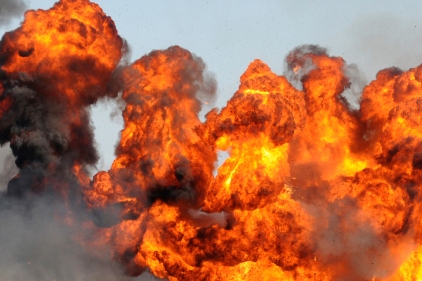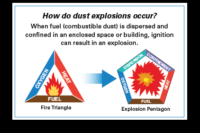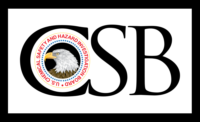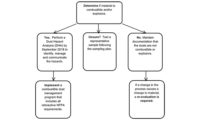Combustible dust Q&A with the Chemical Safety Board

 These questions were submitted from the audience at ISHN’s Sept. 28 webinar on combustible dust lessons learned from CSB investigations.
These questions were submitted from the audience at ISHN’s Sept. 28 webinar on combustible dust lessons learned from CSB investigations.
Providing the responses is Mark Kaszniak, CFEI, CFII, CPEA, Senior Chemical Safety Recommendations Specialist. U.S. Chemical Safety and Hazard Investigation Board, Washington DC.
Question: Can you discuss the NFPA’s recommendation that certain employees involved in the handling of Combustible Dusts wear FR rated clothing, and, is there a rating of protection to target?
Answer: Currently, NFPA 484 requires that either flame resistant or flame retardant clothing be worn by certain employees while engaged in activities involving certain metal dusts (e.g., aluminum, magnesium, titanium). This clothing is typically tested against ASTM standards against flame impingement by flammable gases, or splash protection from a molten metal. Some recent testing by the CSB conducted by a contractor in conjunction with one of our open cases has brought into question the adequacy of these test methods for certification of FR-clothing for protection in combustible dust flash fires.
Although more testing needs to be done in this area, it is possible that existing test protocols may need to be changed or even new ones developed in order to certify FR-clothing for protection against combustible dust flash fire hazards. Of course, relying on protective clothing should be one of the last lines of defense employed against protecting employees from combustible dust flash fires. One should first employ engineering controls (controlling the dust at the source of generation) and work practice controls (good housekeeping, elimination of ignition sources) to protect employees against this hazard.
Question: Since MSDSs do not include dust explosion data, is there a reputable source available for that information?
Answer: Of course, the best source is to have your particular dust tested in accordance with ASTM test protocols. Failing that, you might wish to check with your supplier, as that firm might have data published in a technical bulletin or on a specification sheet that does not appear on the MSDS. Your insurance company may also have information that may help you. Some, like FM Global, have their own dust testing facilities. For more common materials, the NFPA dust standards, or NFPA 68, may have the information you seek (check the Annexes). Some textbooks also contain compilations of this data, such as Rolf Eckhoff’s Dust Explosions in the Process Industries (ISBN 0-7506-3270-4). Finally, the labs at the former U.S. Bureau of Mines (now NIOSH) did extensively testing on many combustible dusts and published their results. These reports can often be found in major university libraries.
Question: As particle size is a factor, what type of dust particles would not be of concern?
Answer: Dust explosions generally occur from to a rapid release of heat due to a chemical reaction. Thus only materials that are not already stable oxides can produce dust explosions. Therefore, silicates, sulfates, nitrates, carbonates, phosphates, Portland cement, sand, limestone and salt are not combustible dusts. Materials that can produce combustible dust explosions include:
• Natural organic materials (grain, linen, sugar, etc.)
• Synthetic organic materials (plastics, organic pigments, pesticides, etc.)
• Coal and peat
• Metals (aluminum, magnesium, zinc, iron, etc.)
As for the effect of particle size, here is how NFPA 654 (2008 edition) explains it:
Dusts traditionally have been defined as a material 420 μm or smaller (capable of passing through a U.S. No. 40 standard sieve). Combustible particulates with an effective diameter of less than 420 μm should be deemed to fulfill the criterion of the definition. However, flat platelet-shaped particles, flakes, or particles of fibers with lengths that are large compared to their diameter usually do not pass through a 420 μm sieve yet still pose a deflagration hazard. Furthermore, many particulates accumulate electrostatic charge in handling, causing them to attract each other, forming agglomerates. Often agglomerates behave as if they were larger particles, yet when they are dispersed they present a significant hazard. Consequently, it can be inferred that any particle that has a surface area to volume ratio greater than that of a 420 μm diameter sphere should also be deemed a combustible dust.
Question: Combustible Dust Explosions, Secondary Explosions and combustible dust Flash Fires all require reaching the Minimum Explosive Concentration (MEC) in order to occur...correct?
Answer: Your statement is true for explosions, but may not be true for flash fires. As with flammable vapor and gas cloud dispersions, combustible dust clouds are rarely uniform in concentration. There are often pockets above and below the lower limit/concentration. If ignited, these pockets can produce a flash fire which may due to momentum/pressure effects extend partially into leaner areas before actually dying out. This is a complex subject with many variables (e.g., type of dust involved, its physical properties, radiative heat transfer, presence of volatiles or inerts in the dust, etc.). If you want to learn more, Rolf Eckhoff devotes an entire chapter (Chapter 4) to this phenomena in his book, Dust Explosions in the Process Industries (ISBN 0-7506-3270-4).
Question: Have you found other international jurisdictions that have had similar investigations and findings? UK? EU etc. How have they succeeded?
Answer: The CSB has seen published accounts of investigations of major dust explosions in several European countries over the past several years. Most of these explosions have been in the agriculture, food and chemical sectors. Most investigations outline the typically problems that seem to be characteristic of most combustible dust explosions (e.g., failure to capture dust at the source of generation, poor housekeeping, numerous uncontrolled ignition sources, lack of hazard awareness, etc.). To our knowledge, France is one of the few countries that changed its regulatory framework as a result of a major dust explosion (Blaye, 1997).
Question: Which state has the most strict combustible dust practices that other states should take note off?
Answer: As part of the Combustible Dust Study, the CSB evaluated whether any OSHA state plan states had combustible dust standards. The CSB found that California was the only state with its own combustible dust standard covering general industry. The California Division of Occupational Safety and Health (Cal-OSHA) standard requires proper housekeeping, electrical grounding, and that dust collectors be placed outdoors.
However, Cal-OSHA personnel told the CSB that enforcing this regulation is difficult because the standard defines dust explosion hazards in terms of a Lower Explosion Limit (LEL). According to Cal-OSHA, the courts have also made enforcement following an explosion difficult because the particle size in the samples collected from settled dust after an explosion are generally larger and heavier than the airborne dust that may have caused the explosion.
Looking for a reprint of this article?
From high-res PDFs to custom plaques, order your copy today!







